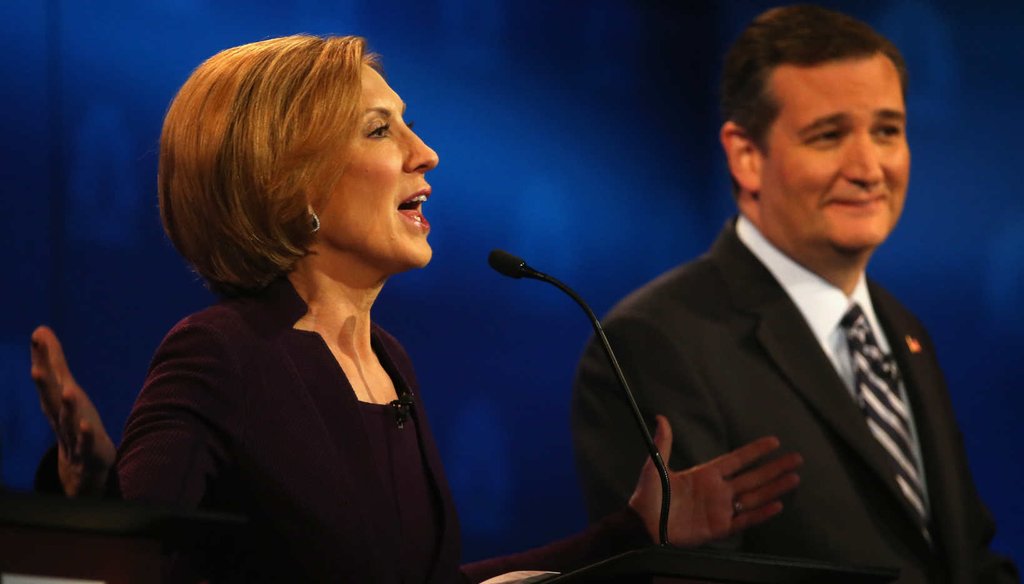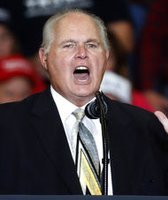Get PolitiFact in your inbox.

Former Hewlett Packard CEO Carly Fiorina gestures during the third Republican presidential debate. (Getty images)
Jeb Bush attacked the records of some his Republican presidential primary opponents Sunday while Carly Fiorina focused her jabs at President Barack Obama.
Bush, who faces increasing questions about his sputtering poll numbers and inconsistent debate performances, stuck by criticisms of Marco Rubio’s attendance record in the U.S. Senate. In an interview on Meet the Press, Bush said he is best positioned to break Washington’s partisan gridlock.
"The basic point with Marco isn't that he's not a good person or he's not a gifted politician; everybody can see that. It's that I have proven leadership skills," Bush said.
"This is about public service, about solving problems. If you look at the three people on the stage from the United States Senate, all three of them have a combined two bills that became law that they've sponsored. If you look at Hillary Clinton, in 10 years, three bills she sponsored that became law," Bush said. "This is the gridlock that I'm running to try to break up. I can change the culture in Washington."
We wanted to focus on Bush’s claim that three senators running for president -- Rubio of Florida, Rand Paul of Kentucky and Ted Cruz of Texas -- have "a combined two bills that became law."
That rates Mostly True.
We evaluated Cruz, Rubio and Paul’s legislative records using Congressional Quarterly’s BillTrack database and GovTrack’s advanced legislation search. We found that Bush’s statement is right that the three senators have sponsored just two bills that eventually became law.
Serving since 2013, Cruz has been the primary sponsor on 57 bills, one of which has become law. Rubio and Paul both joined the Senate in 2011. Rubio has sponsored 106 bills, and President Barack Obama signed one of them into law. Paul has sponsored 141 bills but none has yet to become law.
Cruz’s bill, enacted in 2014, denied admission to the United States any United Nations representative who poses a national security threat (a response to Iran’s chosen U.N. representative). The bill was uncontroversial and passed unanimously in both the Senate and the House.
Obama signed Rubio’s bill in 2015. This law, which authorized the State Department to support women’s rights in developing countries, was also uncontroversial and passed both chambers unanimously.
All three also have their names on laws as cosponsors: Cruz has three, Rubio has 18 and Paul has four.
The caveat in all of this is that passing legislation is just one way to measure the effectiveness of a senator, and experts cautioned us to not read too much into claims such as Bush’s.
In the cases of Cruz, Rubio and Paul, all have been in the Senate for less than five years. And for most of that time, Republicans were in the minority.
"First-term senators have a lot of headwinds, particularly when in the minority," Joshua Huder, senior fellow at Georgetown University’s Government Affairs Institute, told us.
Record poverty rates
On Fox News Sunday, Republican presidential candidate was asked to explain the false statement she made during last week’s debate that "92 percent of the jobs lost during Barack Obama’s first term belonged to women." The claim ignored that last 10 months of Obama’s first term, and factoring that in, the number of women with jobs actually increased by 416,000.
Fiorina said she misspoke and blamed the media.
"This is what the liberal media tries to do. Let us discredit the messenger, so that we ignore the truth of the message. Here is the truth of the message. Women are harmed by this administration's policies. Record numbers of women have lost jobs, are living in poverty or are living in extreme poverty," Fiorina said.
"We have record numbers of people who are no longer working or quit looking for work. We have record numbers of people living on food stamps. We have record numbers of people living in poverty. Those are the facts, that is the truth."
There is plenty to potentially analyze in Fiorina’s comments, but we decided to focus on one specific claim that the United States has "record numbers of people living in poverty."
That rates Half True.
Looking at data from the Census Bureau, Fiorina’s right that the number of people living in poverty (46.7 million in 2014) is the highest since the census began keeping track in 1959. However, the poverty rate — the measure typically used — is nowhere near historical highs.
There are 8 more million people living in poverty now than in 1959, but the overall population of the United States also grew by 141 million people (from 177 million in 1959 to 318 million in 2014). So the poverty rate actually decreased from 22.4 percent in 1959 to 14.8 percent in 2014.
"Most economists would agree that standards of living have increased substantially since 1959, and poverty, especially elderly poverty, was more severe in 1959 than today," said John Iceland, a professor of sociology and demography at Pennsylvania State University and author of Poverty in America.
All the experts we spoke to cautioned against using raw numbers when making comparisons. Instead, analysts typically use rates to correct for the growing population of the nation.
"If we use absolute values and not rates, then the following statements are both true: There are more people who are poor than ever today. But GDP is much higher today than it ever was under a Republican president, so the Obama Administration economic policy is a smashing success," said Sheldon Danziger, the president of the nonpartisan Russell Sage Foundation, which funds research on poverty.
If we use Fiorina’s preferred measure, we reached a record number of people living in poverty under the watch of every president starting with Richard Nixon, Danziger pointed out. Conversely, said George Washington University economist Tara Sinclair, the number of people not living in poverty has also increased.
"No president in the last 40 years has been able to lower the number of people in poverty. Poverty rates fell most under the Bill Clinton Administration than any since Nixon," Danziger said.
Our Sources
See individual fact-checks.
















































